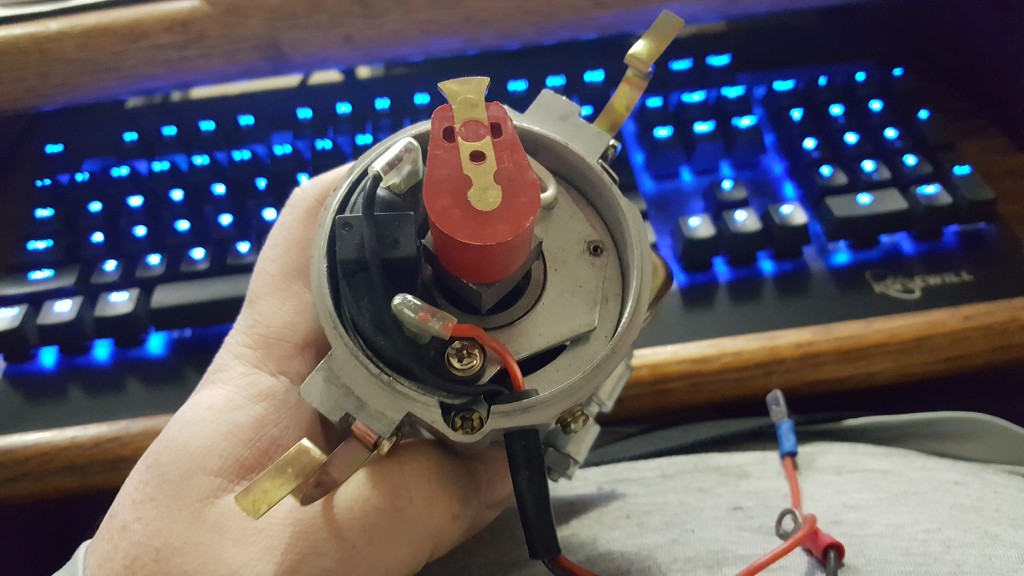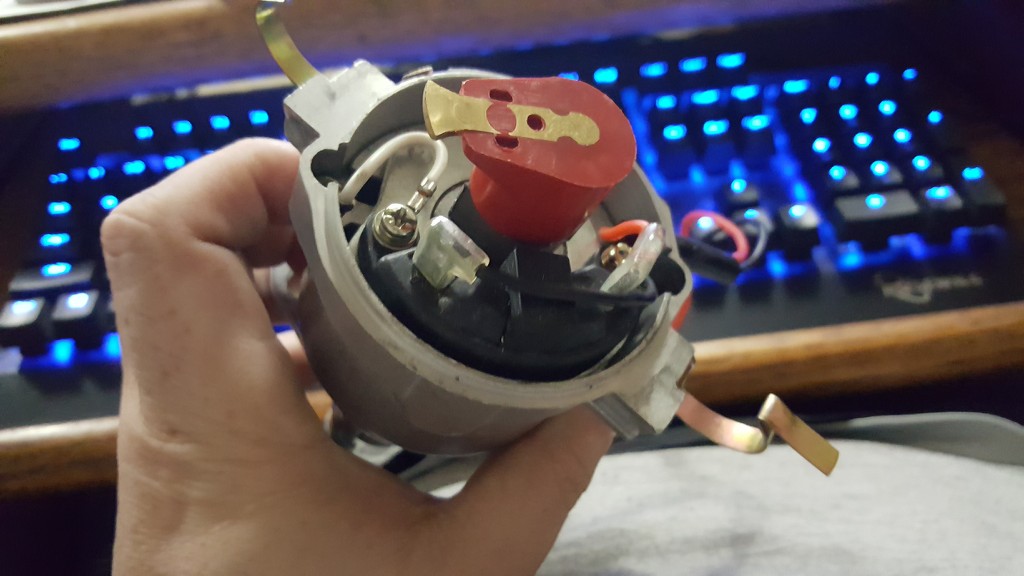| ||||
> Jensen Healey & Jensen GT Tech > VIN Database for Jensen Healey & Jensen GT > Spark Plugs for Lotus 907 - 2.2L Hi Compression Engine |
| ||||
> Jensen Healey & Jensen GT Tech > VIN Database for Jensen Healey & Jensen GT > Spark Plugs for Lotus 907 - 2.2L Hi Compression Engine |
| Moderated by: Greg Fletcher |
|
||||||||||||||
| Spark Plugs for Lotus 907 - 2.2L Hi Compression Engine | Rate Topic |
| Author | Post |
|---|
| Posted: 04-30-2020 10:05 pm |
|
1st Post |
|
Randallclary@icloud.com Member
|
I recently changed plugs on my JH 2.2 vin # 13046. Car has Del 45 Carbs with 104/107 cams. Static Timing 12 deg, 30 deg at 3000 RPM, Just thought it was time. I changed to Iridium IX - NGK BPR6EIX - 6637. - Set the gap at 0.023 in The old plugs were NGK BP7ES with gap set at 0.027 in. Looking for info and comments. Car seems to run slightly better. Seems to take slightly longer to start initially. Last edited on 04-30-2020 10:13 pm by Randallclary@icloud.com |
||||||||||||||
| |||||||||||||||
| Posted: 05-03-2020 05:25 am |
|
2nd Post |
|
Tom Bradley Member
|
Sounds to me that the changes you made should help, at least a little. According to the manual, 0.023" gap is where you should be, at least for standard compression. It depends on other parts of the system, however. For instance, if you have electronic ignition and a high voltage coil you might be able to use a wider point gap without any problems and possibly get more complete combustion. One potential problem, though, is that the distributor cap was not made for these kind of voltages and can go bad quicker. If you still have the original type of ignition this is less of a problem. Either way, if the engine still is not running as good as you expected you might want to look for sparks in the vicinity of the distributor cap just in case. My experience is that putting a thin coating of clear epoxy the outside of the distributor cap seems to extend the lifetime. But I still keep an extra cap around just in case.
|
|||||||||||||
| ||||||||||||||
| Posted: 05-04-2020 12:13 am |
|
3rd Post |
|
Esprit2 Member
|
See the attached JPEG for the spark plug, gap & plug wires Lotus spec'd for their version of the 2.2 equipped with an electronic ignition system and a 'hotter' coil. Current draw is a function of plug gap. It takes more current to jump a larger gap, and breaker points couldn't handle a lot of current. So a breaker points system would limit the plug gap to around 0.023"-0.o26", and the coil to around 23-24,000 volts. The basic Pertronix Ignitor is a 'points replacer' electronic ignition, and limited to similar gaps & volts. Most other aftermarket electronic ignition systems can handle much higher voltages ('hotter' coils) and larger plug gaps up to 0.046-0.048". The Lucas CEI ignition system Lotus used called for 0.035" plug gaps, as noted on the JPEG. I have a 2.2 converted 907 with a Crane Fireball XR700 ignition, a Lucas Gold 'Sport Coil' (nothing 'hot' by today's standards), NGK leads, BPR6ES plugs, and 0.036" gaps, and the engine would pull 8,000 rpm if I needed it during an autocross run. The ignition never missed a beat. The plugs & gaps you use depend upon the coil's potential output, and the current draw your electronic ignition can handle without frying. In the above engine, I fried two Pertronix Ignitors, and three Lumenitions, but the Crane XR700 never complained. The 'Lucas' plug wires mentioned in the JPEG are standard carbon core 'resistor' wires. The 'NGK' wires are 'solid core', similar to Magnecore, etc. Regards, Tim Engel Attachment: Sec TDA - Ignition - Spark Plugs, Gap & Plug Wires.jpg (Downloaded 126 times) Last edited on 05-04-2020 12:22 am by Esprit2 |
||||||||||||||
| |||||||||||||||
| Posted: 05-04-2020 12:46 am |
|
4th Post |
|
Esprit2 Member
|
Tom Bradley wrote:One potential problem, though, is that the distributor cap was not made for these kind of voltages and can go bad quicker. If you still have the original type of ignition this is less of a problem.Good point, I didn't ask what distributor you were using... 23D4/ 25D4, or 43D4/ 45D4? The early 23/25 had a very small head & cap diameter. That put the plug wire terminals close together, and high voltage coils would result in arc'ing between the terminals inside the cap. Lots of spark, but it wasn't going where it needed to go. The small 23/25 isn't compatible with hot coils, so don't go a lot hotter than stock. The later 43/45 distributors were larger in diameter, which spread the plug wire terminals further apart. My 45D4 easily handled the Lucas Gold 'Sport Coil', and Pertronix sells FlameThrower coils for them. I'm not saying that just because Pertronix will sell them that they're right... but there is some street precident for FlameThrower coils mated to 43/45 distributors. Regards, Tim Engel
|
|||||||||||||
| ||||||||||||||
| Posted: 05-04-2020 01:09 am |
|
5th Post |
|
Esprit2 Member
|
I mentioned the Crane XR700 & XR3000 ignition systems. Rather than leave that dangling, I'll finish the thought. It was originally an Allison ignition system, but Allison went out of business. Crane bought the ignition system product line and marketed it for a while. However, Crane is a cam company, and ignition systems were never a big part of their business... so they sold it off. The system had a strong reputation with Harley-Davidson owners, so a Harley aftermarket parts company (S&S ??) bought the ignition system and continued to sell it to bikers and car guys alike. Now it's the FAST XR700 Fireball ignition system, plus a line-up of more modern ignition systems. I bought mine in 1998-99 sometime, and you can still buy the same unit. It's that good... there's still a market for it. But time moves on, and modern systems have more bells & whistles on them, so FAST is selling products like that as well. But I'd still be inclined to buy an XR700 or XR3000. Note that they do not hide inside the distributor. There's only a pick-up in the distributor, but the amplifier is external, in a finned aluminum housing that can be mounted where there's some airflow. That's a major key to why they're so heat resistant... they can be cooled. Pertronix & many others fit inside the closed distributor where there is no cooling... they look stock, but they suffer for it. At Summit Racing... https://www.summitracing.com/parts/fst-700-0231 Regards, Tim Engel Last edited on 05-04-2020 01:13 am by Esprit2 |
||||||||||||||
| |||||||||||||||
| Posted: 05-04-2020 04:26 pm |
|
6th Post |
|
PF18602 Member
|
+1 for the FAST XR700. I went right to that when I rebuilt my distributor when I first got the car. Did a lot of research and it seemed that there was a lot to be said for the optical system, as opposed to Pertronix’s magnetic method of timing. I’ve been using it for almost three years in conjunction with the flamethrower 2 without any issues. My only gripe is that FAST, after all the changes in hands from the original creators, doesn’t know anything technical about it, so they were pretty worthless on the help line. For a couple hundred less than the MSD ignition, it fit the budget nicely. I just wish it had a rev limiter (for when I let someone else drive).. I recall reading a story about a person’s friend missing the brake and hitting the gas. Stupid little pedals.. Best, Patrick
|
|||||||||||||
| ||||||||||||||
| Posted: 05-05-2020 02:28 am |
|
7th Post |
|
Esprit2 Member
|
I perfer magnetic or optical triggers since the engine doesn't have to be cranking at a minimum rpm for them to work. Heck, the engine doesn't even have to be turning over, and that allows you to static time the ignition with a test light or multi-meter. Most modern ignition systems now use Hall Effect sensors, and the engine has to be cranking at 200+ rpm before they work, so there's no chance to accurately static time the distributor before starting the engine. Well, there is, sorta, but it involves 'eyeball' aligning the reluctor with the pick-up. Given the distributor's position on the 907, it's not easy getting the ol' eyeball down there. The Pertronix Ignitor II and Ignitor III use Hall Effect sensors, as does the Lucas CEI system that was in later 43/ 45 distributors (1980-on ?). The basic Pertronix Ignitor used to have a magnetic trigger, and you could static time it. But they had problems with the magnets falling out, and there were a lot of warranty claims. I've not used one in a long time, so I'm out of touch, but I thought I'd heard that the basic Ignitor now uses a Hall Effect sensor as well... is that correct. But yes, getting back to your original point, one convenience 'plus' for the Allison/ Crane/ FAST XR700/ XR/3000 is that they're optically triggered, and can be static timed very easily. Regards, Tim Engel
|
||||||||||||||
| |||||||||||||||
| Posted: 05-05-2020 07:38 am |
|
8th Post |
|
discogodfather Member
|
This trigger on the 43D Lucas copy I ordered from a shop in the UK seems to be using something that hasn't been seen before- a fairly robust (magnetic?) switch which is rubber encased. This was sold as a "high energy" switch and it indeed works great with a .7 ohm dry coil I am using. Spark looks to be really strong comparing it to my older setups. I always have a bit of a chip on my shoulder on Petronix since my Ignitor I stopped working because of a mistake (reverse polarity). These things are sooo expensive and seems kind of cheapo for the price. The Lucas copy was about $75 and did require me to take it apart and machine it for the oil seal, but so far so good.  
|
|||||||||||||
| ||||||||||||||
| Current time is 07:23 am | |
| > Jensen Healey & Jensen GT Tech > VIN Database for Jensen Healey & Jensen GT > Spark Plugs for Lotus 907 - 2.2L Hi Compression Engine | Top |